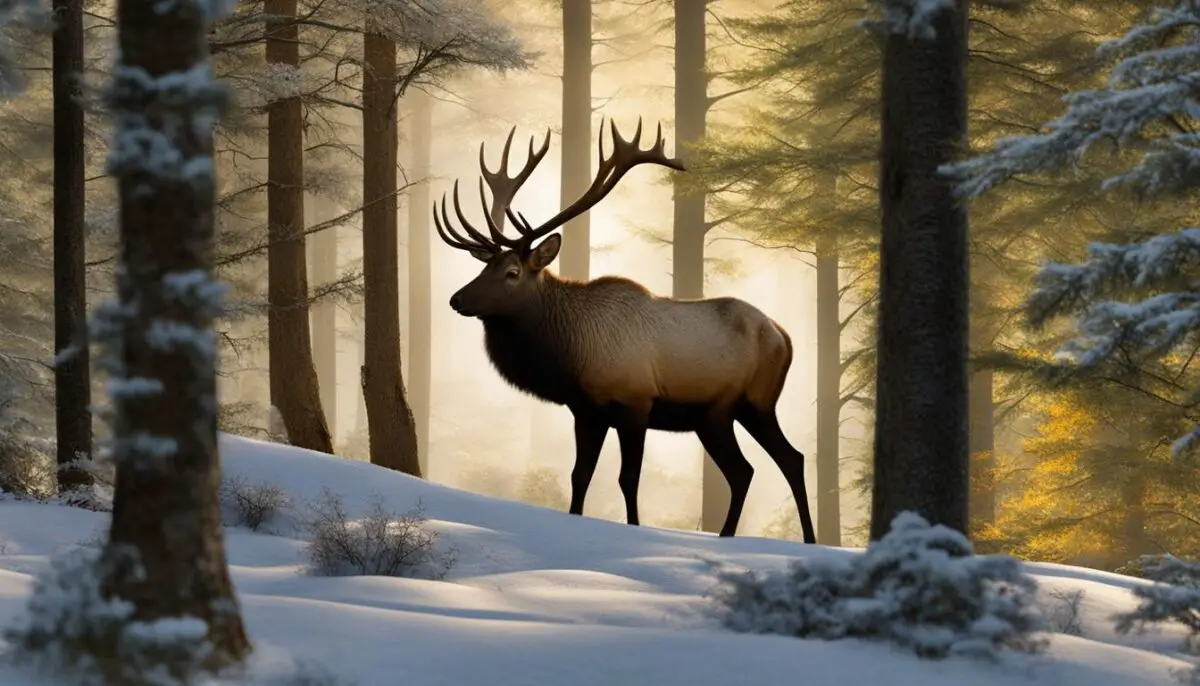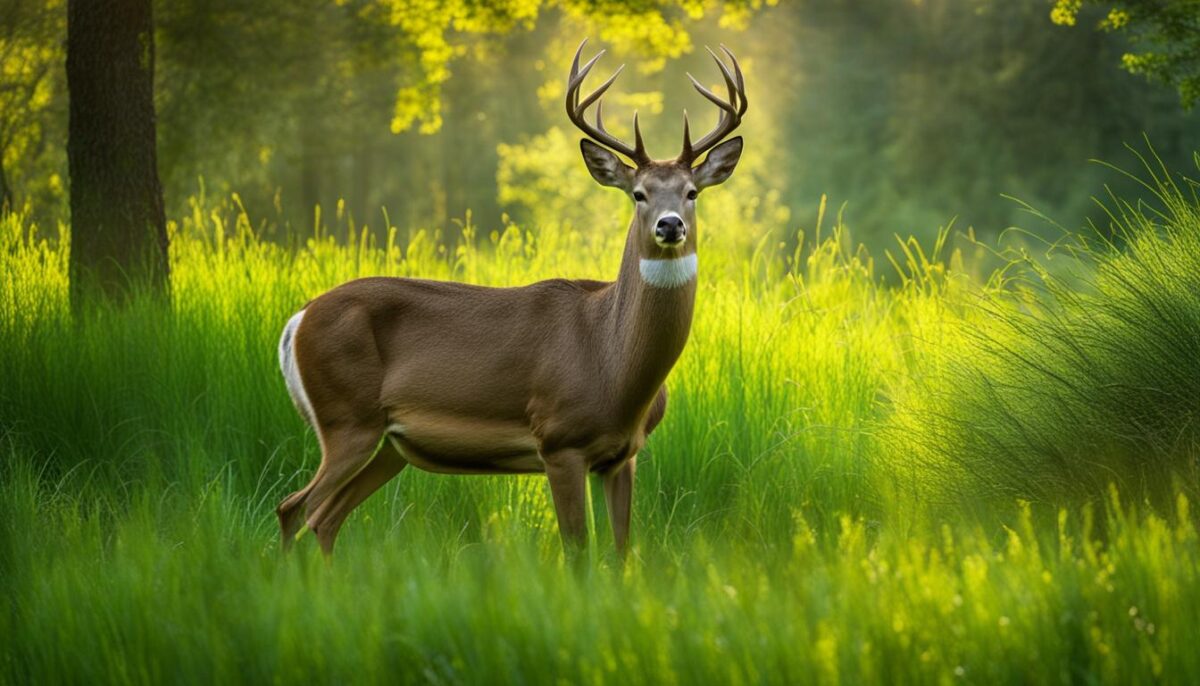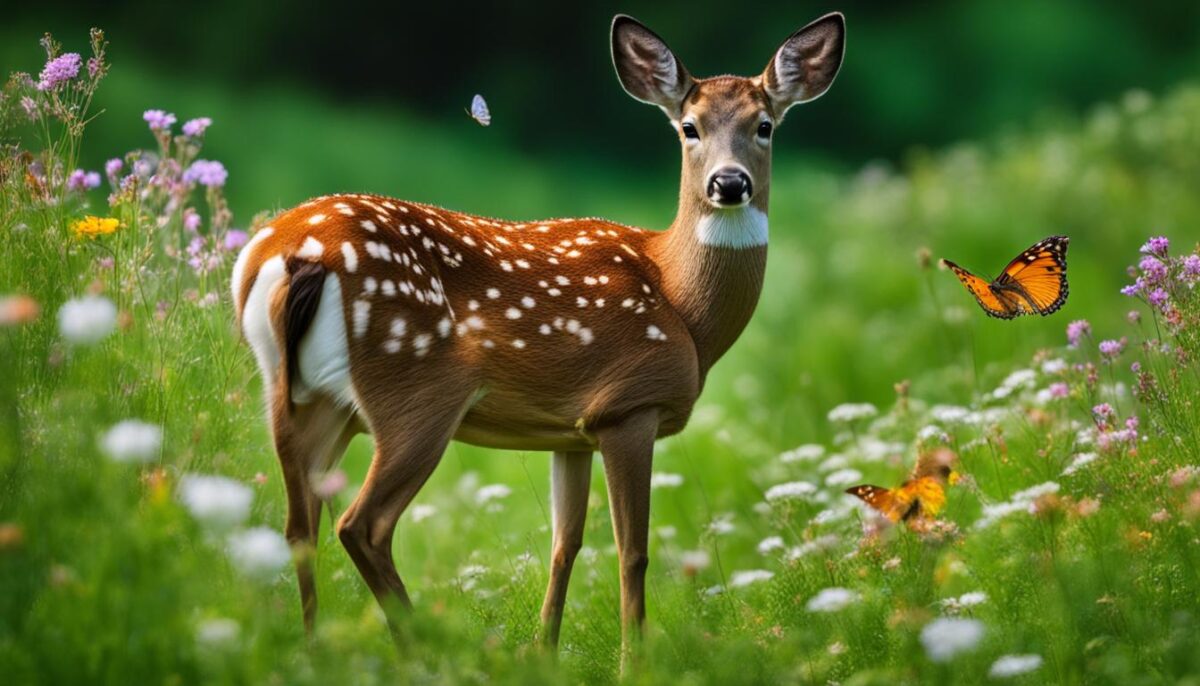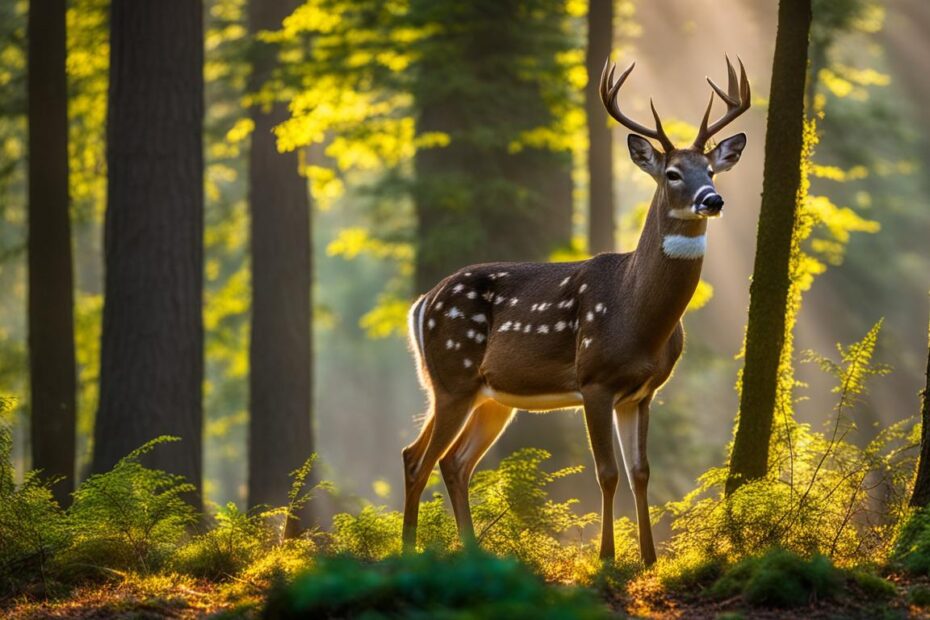When it comes to deer pregnancy, also known as the gestation period, it is important to understand that it varies among different deer species. Knowing the average length of deer pregnancy can provide valuable insights into their reproductive cycle and behavior.
Whitetail deer, one of the most common deer species, have a gestation period ranging from 193 to 205 days. This means that they are pregnant for about 6 and a half months. Mule deer, on the other hand, have a gestation period of approximately 200 days, similar to that of whitetail deer.
It’s worth noting that other deer species have different gestation periods. For example, elk and black-tailed deer have longer gestation periods of around 246 days and 203 days, respectively. The Chital, also known as Axis deer, has a gestation period ranging from 210 to 238 days. Moose, on the other hand, have a gestation period of about 230 days.
Understanding the gestation period of different deer species is crucial for wildlife enthusiasts, hunters, and researchers. It helps in determining the timing of fawn births, assessing buck-to-doe ratios, and overall herd health. Additionally, knowledge of the gestation period contributes to our understanding of the natural history, behavior, and adaptations of these magnificent animals.
Key Takeaways:
- The gestation period of whitetail deer is approximately 193 to 205 days, while mule deer have a gestation period of about 200 days.
- Other deer species, such as elk, black-tailed deer, Chital, and moose, have longer gestation periods.
- Understanding the gestation period helps in assessing buck-to-doe ratios, fawn drop timing, and overall herd health.
- Nutrition and photoperiod play a crucial role in deer breeding and the timing of fawn births.
- Advancements in reproductive techniques, such as artificial insemination, contribute to the genetic improvement of deer populations.
Understanding the Whitetail Deer Gestation Period
The gestation period for whitetail deer is approximately 193 to 205 days, which means female whitetail deer are pregnant for about 6 and a half months.
Whitetail does that are bred in early November would likely give birth in mid-May to early June, coinciding with the availability of food and favorable weather conditions.
During this time, the distinctive spotted coat of a whitetail fawn can be seen. These spots typically fade 3 to 4 months after birth. By knowing the gestation period, hunters and wildlife enthusiasts can determine the approximate conception date and estimated birth date of whitetail fawns.
Table: Whitetail Deer Gestation Period
| Deer Species | Gestation Period |
|---|---|
| Whitetail Deer | 193 to 205 days |
| Mule Deer | Approximately 200 days |
| Elk | Approximately 246 days |
| Black-Tailed Deer | Approximately 203 days |
| Axis Deer (Chital) | 210 to 238 days |
| Moose | Approximately 230 days |
Exploring the Gestation Period of Mule Deer
Mule deer, like their whitetail counterparts, have a gestation period of approximately 200 days, which means that mule deer females are pregnant for about 6 and a half months. This similarity in gestation periods highlights the evolutionary adaptations of both species to their respective breeding strategies. While there are similarities between mule deer and whitetail deer, there are also some distinguishing differences to take note of.
Differences between Mule Deer and Whitetail Deer
One of the main differences between mule deer and whitetail deer is their physical characteristics. Mule deer have large mule-like ears, hence their name, while whitetail deer have smaller ears. Mule deer also have a dark forehead patch, contrasting with the white rump patch that is characteristic of whitetail deer. Another notable distinction is their behavior. Mule deer are known for their leaping ability and can jump heights of up to 8 feet, whereas whitetail deer rely more on their agility and quick movements. In terms of habitat preferences, mule deer are commonly found in arid and mountainous regions, while whitetail deer are more adaptable to a variety of environments and can be found in forests, grasslands, and even suburban areas.
Understanding the gestation period of mule deer, and the differences between mule deer and whitetail deer, provides valuable insights into the natural history and biology of these species. It allows researchers, wildlife managers, and enthusiasts to better understand their reproductive cycles and adapt management strategies accordingly.
Table: Comparing Mule Deer and Whitetail Deer
| Characteristics | Mule Deer | Whitetail Deer |
|---|---|---|
| Physical Characteristics | Mule-like ears, dark forehead patch | Smaller ears, white rump patch |
| Behavior | Leaping ability, can jump up to 8 feet | Agile, quick movements |
| Habitat Preferences | Arid and mountainous regions | Varied environments, forests, grasslands, suburban areas |
The table above summarizes the key differences between mule deer and whitetail deer. It is important to note that even within these species, there can be variations in physical characteristics and behavior based on regional variations and individual traits. However, understanding these general distinctions can aid in species identification and enhance our overall understanding of deer biology.
Understanding the Gestation Period of Elk
Elk, also known as wapiti, have a longer gestation period compared to whitetail deer and mule deer. The average gestation period for elk is approximately 246 days, which means that female elk are pregnant for about 8 months. This extended pregnancy allows for the development of elk calves that are more physically prepared to survive in their environment. The breeding season, or rut, for elk occurs from late August to late October when bulls actively compete for the attention of receptive cows. This period of intense mating activity increases the chances of successful conception and subsequent pregnancy.
Elk calves are typically born in May or June when food sources are abundant, and favorable weather conditions provide a conducive environment for their survival. The timing of moose calf birth is crucial for their growth and development. Calves must have enough time to grow strong and gain necessary skills before the onset of winter. The longer gestation period of elk contributes to the overall reproductive strategy and survival of the species in their natural habitat.

| Gestation Period | Peak Breeding Season | Birth Season |
|---|---|---|
| Approximately 246 days | Late August to late October | May to June |
The gestation period and breeding season of elk play vital roles in the life cycle of this majestic species. Understanding these reproductive patterns helps wildlife enthusiasts and conservationists assess the health and sustainability of elk populations in their natural habitats.
Exploring the Black-Tailed Deer Gestation Period
Black-tailed deer, a species found in the coastal regions of the western United States, have a gestation period of approximately 203 days. This means that female black-tailed deer are pregnant for about 6 and a half months, similar to their whitetail and mule deer counterparts. Understanding the gestation period of black-tailed deer provides valuable insight into their reproductive cycle and population dynamics.
The black-tailed deer’s gestation period is an important consideration for wildlife managers and researchers. It helps in predicting the timing of fawn births, which, in turn, influences population estimates and management strategies. Monitoring the pregnancy length of black-tailed deer allows for the assessment of the overall health and reproductive success of the population.
Similar to other deer species, the gestation period of black-tailed deer plays a significant role in their survival and adaptation to their environment. It ensures that the young are born during favorable seasons, providing them with the best chance of survival. The timing of birth is influenced by factors such as nutrition, photoperiod, and habitat conditions.
| Deer Species | Gestation Period (Days) |
|---|---|
| Whitetail Deer | 193-205 |
| Mule Deer | 200 |
| Black-Tailed Deer | 203 |
| Elk | 246 |
| Axis Deer (Chital) | 210-238 |
| Moose | 230 |
By studying and understanding the gestation period of black-tailed deer, researchers and wildlife managers can make informed decisions regarding population management, habitat conservation, and overall wildlife preservation.
Understanding the Axis Deer Gestation Period
The gestation period for Axis deer, also known as Chital, ranges from 210 to 238 days. This means that Axis deer females are pregnant for approximately 7 to 8 months. Axis deer are native to South Asia but have been introduced to various regions around the world. The variation in gestation period among different deer species reflects their unique reproductive cycles and adaptations.
“The gestation period for Axis deer females is longer compared to other deer species, such as whitetail and mule deer. This extended pregnancy allows for the development of well-prepared calves. It is essential for Axis deer to have a longer pregnancy to ensure the survival and fitness of their offspring in their native environments.”
The longer gestation period of Axis deer showcases their evolutionary adaptation to their specific habitat and provides them with an advantage for survival. This extended pregnancy allows for the proper development of the fawn and gives them a better chance of thriving in their native environments.
The Variation in Gestation Periods Among Deer Species
When comparing the gestation periods of different deer species, it is fascinating to observe the variations in length. Whitetail and mule deer have shorter gestation periods of approximately 6 and a half months, while Axis deer have a significantly longer gestation period of 7 to 8 months. These differences in gestation periods can be attributed to various factors, including environmental conditions, habitat, and evolutionary adaptations.
Understanding the gestation period of Axis deer provides valuable insights into their reproductive biology and helps researchers and wildlife enthusiasts appreciate the diverse strategies and adaptations within the deer family. By studying these unique aspects of deer reproduction, we can further our knowledge and contribute to the conservation and management of these magnificent animals.
| Deer Species | Gestation Period |
|---|---|
| Whitetail Deer | 193 to 205 days |
| Mule Deer | Approximately 200 days |
| Axis Deer (Chital) | 210 to 238 days |
Exploring the Moose Gestation Period
Moose, one of the largest members of the deer family, have a gestation period of about 230 days. This means that female moose are pregnant for approximately 7 and a half months. Moose calves are typically born from mid-May to early June, coinciding with the availability of food and favorable weather conditions. The timing of moose calf birth is crucial for their survival in the wild, as it allows them to take advantage of the abundant vegetation and mild temperatures of the early summer.
Moose pregnancies follow a similar pattern to other deer species, with the females being in estrus, or heat, for a short period of time. The actual mating process can last between 30 to 60 seconds, during which the male transfers sperm to the female. After successful fertilization, the female moose carries her developing calf for the gestation period until it is ready to be born.
Moose calves are born weighing around 30 to 35 pounds and are already well-equipped to navigate their surroundings. They can walk within a few hours of being born and are able to keep up with their mothers shortly after. The calves rely heavily on their mothers for protection and nourishment during their first year of life, gradually becoming more independent as they grow.
| Key Information about Moose Gestation | |
|---|---|
| Gestation Period | Approximately 230 days |
| Timing of Moose Calf Birth | Mid-May to early June |
| Calves’ Weight at Birth | Approximately 30 to 35 pounds |
The gestation period and timing of moose calf birth are essential factors for the survival and reproduction of moose populations. Understanding these aspects allows wildlife managers to monitor population dynamics and assess the health of moose herds. By studying the gestation period and observing the timing of moose calf births, researchers can gain insights into the reproductive success and overall fitness of these magnificent animals.
The Influence of Nutrition and Photoperiod on Deer Breeding
Nutrition and photoperiod play crucial roles in the breeding and reproductive cycles of deer. Adequate nutrition is essential for maintaining the overall health and reproductive ability of deer. A well-balanced diet ensures that deer have the necessary nutrients and energy to support successful breeding and pregnancy. This includes providing sufficient protein, carbohydrates, vitamins, and minerals that contribute to the overall well-being of deer populations.
Proper nutrition is especially important during critical periods such as the rut and the gestation period. Bucks require adequate nutrition to develop healthy antlers and maintain their physical condition during the intense mating season. Does, on the other hand, need to maintain optimal body condition to support conception, implantation, and embryonic development. Insufficient nutrition during these periods can lead to reduced fertility, lower birth rates, and compromised fawn health.
Photoperiod, or the length of daylight hours, also plays a significant role in deer breeding. Whitetail deer, for example, are considered “short-day breeders.” As the days become shorter in the fall, the decreasing photoperiod triggers physiological changes in does and bucks that influence their reproductive behavior. It stimulates the release of hormones that regulate the breeding season, including the timing of estrus in does and the rut in bucks.
Understanding the interaction between nutrition and photoperiod is essential for managing deer populations effectively. By implementing habitat management practices that provide nutritious forage and maintaining natural or artificial photoperiod fluctuations, wildlife managers can optimize deer breeding success and population health. These practices contribute to the conservation and sustainable management of deer species, ensuring their long-term viability in their respective ecosystems.

The Role of Nutrition and Photoperiod in Deer Breeding
“Proper nutrition is essential for maintaining the overall health and reproductive ability of deer. A well-balanced diet ensures that deer have the necessary nutrients and energy to support successful breeding and pregnancy.”
Table 1: Factors Affecting Deer Gestation Period
| Factor | Influence |
|---|---|
| Nutrition | Optimal nutrition supports reproductive health and successful breeding |
| Photoperiod | Triggers hormonal changes that regulate breeding seasons |
| Species | Each deer species has a unique gestation period range |
| Environment | Factors such as climate and habitat conditions can influence gestation |
- Proper nutrition is crucial for maintaining the overall health and reproductive ability of deer.
- Adequate nutrition supports successful breeding and pregnancy.
- Photoperiod, or the length of daylight hours, triggers physiological changes in deer that influence their breeding behavior.
- Understanding the role of nutrition and photoperiod helps wildlife managers optimize deer breeding success and population health.
The Significance of Gestation Period for Deer Management
Gestation period plays a crucial role in deer management strategies, offering valuable insights into fawn drop timing, buck-to-doe ratios, and overall herd health. Understanding the gestation period allows managers to assess the reproductive success of the deer population and make informed decisions to maintain a healthy and balanced herd.
Accurate knowledge of fawn drop timing provides valuable information about the breeding season’s success and the population’s future growth. Late-born fawns may indicate an imbalance in the deer population, affecting the overall dynamics and genetic diversity. By monitoring the fawn drop timing based on the gestation period, managers can identify trends and implement appropriate management practices to promote the deer population’s well-being.
Buck-to-doe ratios are crucial for monitoring the breeding success and herd dynamics. By analyzing the timing of conception and fawn births, managers can assess buck-to-doe ratios and determine if there is adequate breeding activity. Imbalanced ratios may suggest issues such as low buck populations or an overabundance of does, impacting the overall reproductive capacity and genetic diversity of the herd. Understanding the gestation period is essential for evaluating and maintaining balanced sex ratios within the deer population.
Herd health is a vital aspect of deer management, and the gestation period provides valuable insights into the overall well-being of the population. By monitoring the fawn drop timing, managers can assess the reproductive success of does and evaluate the health and condition of the herd. Healthy fawns are essential for the long-term survival and population growth of deer species. Understanding the gestation period allows managers to identify any potential issues affecting herd health and take appropriate measures for conservation and population management.
Table: Factors Influenced by Gestation Period in Deer Management
| Aspect | Significance |
|---|---|
| Fawn Drop Timing | Allows assessment of breeding season success and identification of imbalances in the population |
| Buck-to-Doe Ratios | Evaluates breeding activity, identifies imbalanced ratios, and ensures genetic diversity |
| Herd Health | Assesses reproductive success, fawn survival, and overall population condition |
Research and Techniques for Deer Reproduction Enhancement
Researchers and wildlife professionals have made significant advancements in enhancing deer reproduction through various techniques. These techniques include artificial insemination and synchronization protocols for deer breeding. By implementing these methods, experts can selectively breed deer with superior genetics, ultimately improving desirable traits like antler development and overall herd health.
Artificial insemination (AI) in deer involves collecting semen from high-quality bucks and inseminating does using specialized techniques. AI allows breeders to control the mating process and introduce desired genetic traits into the population. This technique is particularly valuable for captive deer breeding programs and conservation efforts focused on preserving and enhancing specific deer species.
In addition to AI, synchronization protocols play a vital role in optimizing deer breeding. These protocols aim to ensure does come into heat at the same time, increasing the chances of successful breeding and pregnancy rates. By synchronizing estrus, wildlife professionals can efficiently manage deer populations, improve genetic diversity, and maximize reproductive outcomes.
| Technique | Benefits |
|---|---|
| Artificial Insemination (AI) | Controlled breeding, introduction of desired genetic traits, enhanced antler development |
| Synchronization Protocols | Efficient management, improved reproductive outcomes, enhanced genetic diversity |
By combining artificial insemination and synchronization protocols, wildlife professionals can accelerate genetic improvement and ensure the long-term viability of deer populations. These techniques are essential tools in deer reproduction enhancement, offering both practical and scientific benefits for conservation efforts, breeding programs, and wildlife management initiatives.

Understanding Deer Gestation Period: A Key to Wildlife Knowledge
Knowledge of the gestation period of deer species is crucial for gaining a comprehensive understanding of wildlife and for effective wildlife management. By delving into the intricacies of deer pregnancy, we can gain insights into their unique reproductive cycles, behaviors, and adaptations.
The gestation period of deer, ranging from 193 to 246 days depending on the species, plays a vital role in determining the timing of fawn births. This information is invaluable to hunters, wildlife enthusiasts, and researchers, allowing them to plan and observe the natural beauty of newborn fawns in the wild.
Furthermore, understanding deer gestation provides a deeper understanding of the natural history of these magnificent creatures. It allows us to connect the dots between their breeding strategies, environmental factors, and population dynamics, contributing to the preservation and sustainable management of deer populations.
As we continue to expand our knowledge and conduct research on deer gestation, we unlock valuable insights into their lives and the intricate web of interactions within ecosystems. By recognizing the importance of understanding deer pregnancy, we pave the way for a more informed and responsible approach to wildlife conservation and management.
FAQ
How long are deer pregnant?
The gestation period varies among different deer species, but generally, deer are pregnant for around 6 and a half months.
What is the gestation period of whitetail deer?
Whitetail deer have a gestation period ranging from 193 to 205 days, which means they are pregnant for about 6 and a half months.
When do whitetail fawns typically get born?
Whitetail does bred in early November would likely give birth in mid-May to early June.
What is the gestation period of mule deer?
Mule deer have a gestation period of approximately 200 days, which is similar to that of whitetail deer.
What are the differences between mule deer and whitetail deer?
Despite their similar gestation periods, mule deer and whitetail deer have distinct differences in their physical characteristics, behavior, and habitat preferences.
How long is the gestation period of elk?
The average gestation period for elk is approximately 246 days, which is longer compared to whitetail and mule deer.
When do elk calves typically get born?
Calves are typically born in May or June, following the breeding season that ranges from late August to late October.
What is the gestation period of black-tailed deer?
The gestation period for black-tailed deer is approximately 203 days, similar to whitetail and mule deer.
How long are Axis deer pregnant?
The gestation period for Axis deer, also known as Chital, ranges from 210 to 238 days, meaning they are pregnant for approximately 7 to 8 months.
What is the gestation period of moose?
Moose have a gestation period of about 230 days, which means moose females are pregnant for approximately 7 and a half months.
How does nutrition and photoperiod influence deer breeding?
Adequate nutrition and changing photoperiods play a crucial role in triggering the reproductive cycles of deer, including estrus in does and rut in males.
Why is the gestation period significant for deer management?
Understanding the timing of fawn drop based on the gestation period allows managers to assess buck-to-doe ratios and overall herd health, ensuring a healthy and balanced deer population.
What techniques are used to enhance deer reproduction?
Researchers and wildlife professionals utilize techniques such as artificial insemination and synchronization protocols to selectively breed deer with superior genetics and improve traits like antler development.
Why is understanding deer gestation period important?
Understanding the gestation period of deer species provides insights into their natural history, behavior, and adaptations, contributing to wildlife knowledge and the preservation of these magnificent animals.


